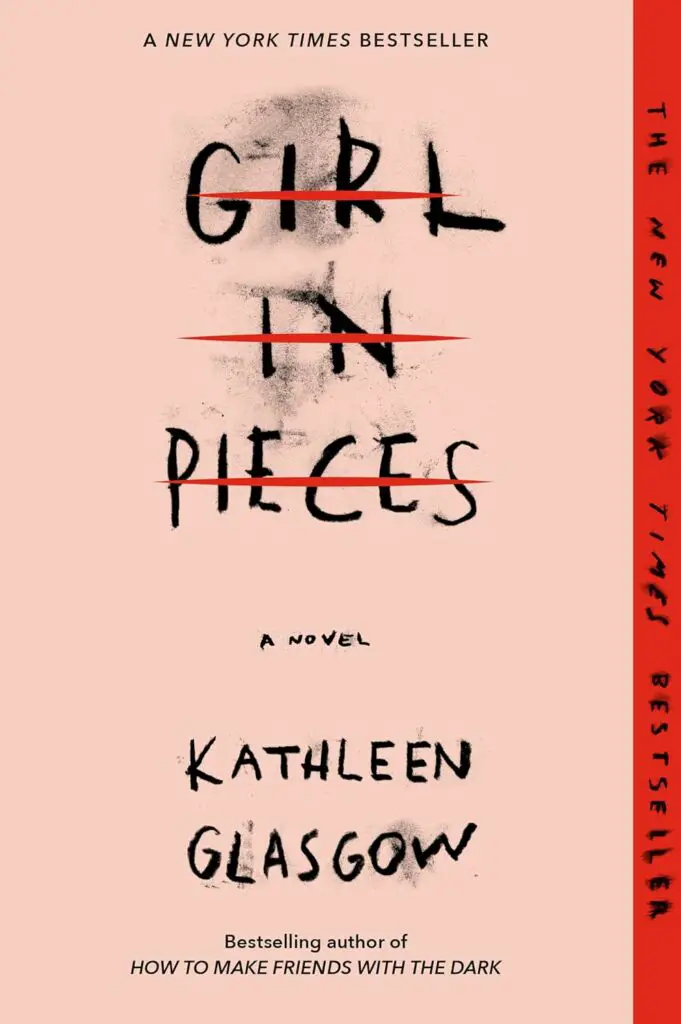Girl in Pieces by Kathleen Glasgow
Main Topic or Theme of the Book
“Girl in Pieces” explores the theme of trauma, self-harm, and the journey towards healing and self-discovery among adolescents.
Key Ideas or Arguments Presented
- Trauma and Self-Harm: The novel portrays the devastating effects of trauma, leading the protagonist, Charlie, to cope through self-harm.
- Healing and Recovery: Through Charlie’s journey, the book illustrates the arduous process of healing and the importance of finding strength and support in overcoming adversity.
- Identity and Self-Discovery: Central to the narrative is the exploration of identity and self-discovery amidst pain and hardship, as Charlie struggles to reconcile her past with her present.
Chapter Titles or Main Sections of the Book
The novel is structured into chapters that follow Charlie’s journey chronologically, from her time in a treatment center to her attempts to rebuild her life afterward.
Key Takeaways or Conclusions
- Resilience: Despite the traumas she faces, Charlie demonstrates resilience and the capacity for growth, highlighting the human ability to endure and overcome.
- Importance of Support: The novel underscores the significance of supportive relationships in the healing process, emphasizing the role of friends, mentors, and counselors in Charlie’s journey.
- Self-Acceptance: Ultimately, “Girl in Pieces” advocates for self-acceptance and the embrace of one’s scars, both physical and emotional, as integral parts of one’s identity.
Author’s Background and Qualifications
Kathleen Glasgow draws from her experiences working with at-risk youth, bringing authenticity and empathy to her portrayal of Charlie’s struggles. Glasgow’s background enriches the narrative, lending it credibility and depth.
Comparison to Other Books on the Same Subject
“Girl in Pieces” shares thematic similarities with other contemporary young adult novels like “Speak” by Laurie Halse Anderson and “Cut” by Patricia McCormick, which also explore themes of trauma and self-harm among adolescents. However, Glasgow’s novel stands out for its raw and unflinching depiction of Charlie’s journey towards healing.
Target Audience or Intended Readership
The book is primarily aimed at young adult readers grappling with issues of trauma, self-harm, and identity formation. It serves as a poignant and relatable narrative for those navigating similar challenges in their own lives.
Explanation and Analysis of Each Part with Quotes
- Part 1: Breaking: This section introduces Charlie and her struggles with self-harm and trauma. It sets the stage for her journey towards healing.
- Quote: “Sometimes I look in the mirror and wonder if I’m still there.”
- Part 2: Bleeding: Charlie confronts the challenges of her past while navigating her present circumstances, including friendships and relationships.
- Quote: “I cut because I want to feel alive. I cut because I am alive. I cut because I want to feel.”
- Part 3: Healing: This part focuses on Charlie’s efforts to heal and rebuild her life, finding solace and strength in her relationships and creative outlets.
- Quote: “You can be shattered and still have enough sharp edges to protect yourself.”
Main Quotes Highlights
- “Sometimes I look in the mirror and wonder if I’m still there.”
- “I cut because I want to feel alive. I cut because I am alive. I cut because I want to feel.”
- “You can be shattered and still have enough sharp edges to protect yourself.”
Reception or Critical Response to the Book
“Girl in Pieces” received widespread acclaim for its poignant portrayal of trauma and self-discovery. Critics praised Glasgow’s raw and honest depiction of Charlie’s journey, noting its emotional resonance and powerful storytelling.
Recommendations (Other Similar Books on the Same Topic)
- “Speak” by Laurie Halse Anderson
- “Cut” by Patricia McCormick
- “Wintergirls” by Laurie Halse Anderson
The Book from the Perspective of Mothers
Biggest Takeaway
“Girl in Pieces” underscores the resilience of the human spirit and the transformative power of self-acceptance in overcoming trauma and self-destructive tendencies, resonating with readers through its authentic portrayal of pain and healing.
